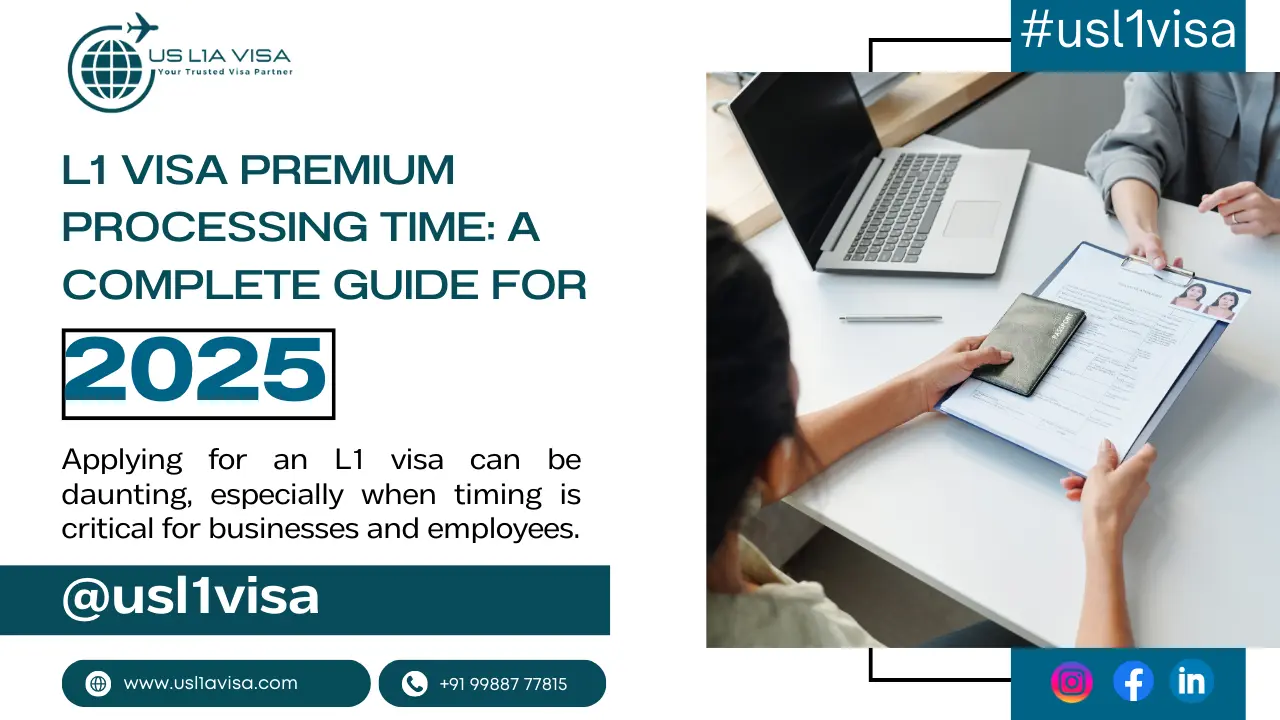L1 Visa Premium Processing Time: A Complete Guide for 2025
Applying for an L1 visa can be daunting, especially when timing is critical for businesses and employees. The premium processing option provides a fast-track solution to promote applications. This comprehensive guide delves into everything you need to know about the L1 visa premium processing time.
What is the L1 Visa?
The L1 visa category is mainly for intra-company transferees. It is also valid when foreign enterprises move their employees with certain specialization or management experiences to related firms in the United States. The latter concepts might refer to branches, subsidiaries or parent organizations in this regard. There are two primary categories of L-1 visas:
- L1A Visa: For executives or managers.
- L1B Visa: For employees with specialized knowledge.
Understanding Premium Processing for L1 Visas
The USCIS service is a path through which an applicant is in a position to receive priority processing of his or her visa. For an extra charge, USCIS agrees to complete your request within 15 calendar days.
Businesses also need the L1 visa to transfer employees without extra days; thus, requesting the premium processing of L1 visas is essential. The priority here is the L1 visa premium processing time which is more important for any kind of work, specifically for the projects and critical business.
How Does Premium Processing Work?
Premium processing is an immigration benefit program provided by the USCIS for the processing of certain visas which include the L1 visas. It sets a 15 calendar day processing time, enabling businesses and employees to meet their exigent circumstances or operational requirements. It starts with the filing of Form I-907, Request for Premium Processing Service together with Form I-129, Petition for a Nonimmigrant Worker. These forms must be filled out correctly and submitted with the premium processing fee which in 2025 is $2,500. After they receive these documents and the payment, USCIS promises to process the application within 15 working days.
The applicants will receive a refund of the premium processing fee in case USCIS has not completed the case within fifteen days while the application is prioritized. During this period applicants are also informed as the USCIS process places high emphasis on communication when it comes to additional documents and clarifications. This is especially so as premium processing applies when it can solve urgent issues, such as moving key employees to other locations necessary for a business’s critical projects or its expansion. However, it does not have a significant impact on the results of the application – it only accelerates it. Through the options provided for premium processing, companies are assured of their planning and time with no hurdles in their way.
Key Benefits Of Premium Processing Time
Benefits require faster visa processing than ever before. This choice is of utmost useful where timing is a factor of consideration, to enable key persons to move quickly to meet organizational needs. Here’s a closer look at the main advantages:
1. Guaranteed 15-Day Processing
Benefits that can be pointed at a premium processing strategy include the following, The most prominent of these would be the fact that the process is timed to take not more than 15 calendar days. This commitment from USCIS helps in the efficient running of the business without much delay. If the processing is not accomplished within this period, USCIS returns the fee while at the same time addressing other cases.
2. Faster Employee Relocation
Such projects have a time constraint and many a time generalized staff has to be shifted urgently to accommodate the key personnel. The faster L1 visa premium processing helps businesses to quickly place their employees so that vital work is not slowed down by bureaucratic procedures.
3. Predictability for Planning
Whereas, in normal circumstances, visa processing often takes months, premium processing offers a dependable schedule. This makes it easy for businesses to schedule projects, meetings, and operations among themselves.”
4. Simplified Communication
Premium processing cases are usually faster in their communication with USCIS, and when there are problems such as an RFE it can be completed quickly.
Selecting the L1 visa premium processing time is the best and perfect way for any company that is willing to invest in its human resource to seal the best mode to manage its international talent.
Step-by-Step Process for Premium Processing
- Determine Eligibility
From there, validate that your case meets the criteria for premium processing, and check that all forms are filled out correctly and in full.
- Prepare the Required Documentation
The documents that may be included are employment contracts, an organization chart, proof that the employee has special skills or knowledge, and proof that the employee is a manager.
- Complete Form I-129
It is the first and overall petition for the nonimmigrant worker or transient immigrant.
- File Form I-907
The form to be used alongside Form I-129 is the form of the premium processing request.
- Pay the Fees
The premium processing fee and other filing fees must be included.
Comparing Regular vs. Premium Processing Times
In this type of visa, it becomes important for businessmen and employees separately to know the regular and the speedy processing of their application. The choice between these two options mostly tends to depend on the question of – urgency, costs and desirable schedule. Here’s a detailed comparison to help you decide:
- Processing Speed
- Regular Processing: It costs at least $160, and as noted, standard L1 visa applications can take from several months. It is always different depending on the USCIS workload and the specific case might take longer depending on how complicated the case is.
- Premium Processing: The premium service ensures a decision on whether to grant an application, deny it or issue an RFE within a 15 calendar days period.
- Cost
- Regular Processing: The standard filing fees are charged according to the visa type and personal situation of the applicant.
- Premium Processing: In addition to the standard costs, an additional $2,500 is charged for the premium processing (applicable since 2025).
- Use Cases
- Regular Processing: Especially beneficial for scenarios where timelines longer than normal are suitable due to the fact that they do not affect the functioning of the organization or its strategy.
- Premium Processing: Most effective for emergencies, for instance when the requirements are needed for project implementation, necessary relocation, or when the beginning of the-Shooting is strictly set out.
- Predictability and Assurance
- Regular Processing: Processing times are less precise because of the difference in the USCIS workload.
- Premium Processing: Ensures an established period, which gives business and employees more definite schedule reliability.
- USCIS Communication
- Regular Processing: Answers received in replying to inquiries or with respect to some problems could also be delayed by standard working service desks.
- Premium Processing: Requests and inquiries to an application are usually answered more promptly than to individuals.
Conclusion
L1 visa premium processing time is still among the fastest and most efficient procedures that can be recommended for intracompany transferees to ensure they get their approvals on time. This article will help people who are applying for loans, as well as business people who want to expand their business by having clear knowledge of this process, which will save time, reduce stress, and increase organizational performance. Taking facts into consideration and getting ready for what’s to come in 2025, this can be considered one of the most useful services.
Frequently Asked Question
Question 1. How long does it take to get the L1 visa premium processed?
Answer. L1 visas may take time to be processed. On average, this may be any time between three to six months. There is the super-charge processing which costs firms some more money, and the decision-making only takes 15 days.
Question 2. Will USCIS processing times improve in 2025?
Answer. Of course, processing times of most general applications are still employed rather quickly and at some pre-pandemic rates more often than not they are even swifter. Indeed, the processing time of Form I-129F, the fiance petition, was much faster in 2024.
Question 3. Who is eligible for premium processing?
Answer. Premium processing ensures that USCIS will work on the I-539 Change of Status applications within 30 calendar days provided there are certain conditions such as receipt of biometrics are fulfilled. Applicants that want to request a change of status to F and M visa, spouse or child of F or M visa holder, J and J dependent applicants are entitled to premium processing.


